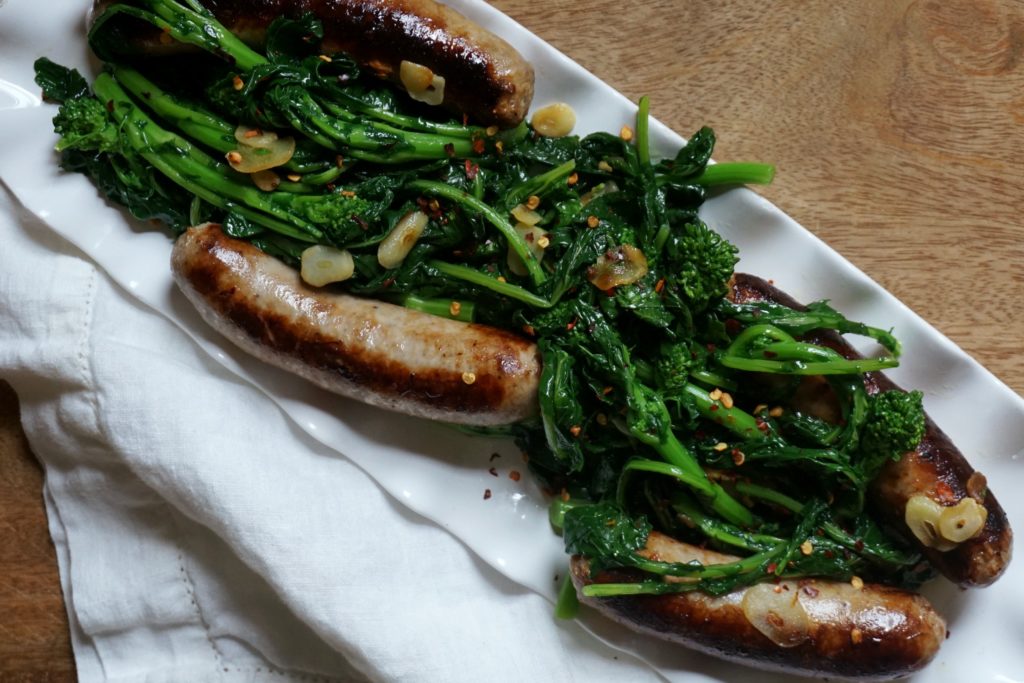
🎁 Holiday Special: SAVE 52% on the Nutrition Coach Starter Package. Limited number remaining.

🎁 Holiday Special: SAVE 52% on the Nutrition Coach Starter Package. Limited # left.

Rapini, also called broccoli rabe (or raab), is a delightfully bitter member of the Brassica family. However, if the bitterness of rapini does not delight you but rather wrinkles your nose, here’s an insider’s tip: Try buying rapini late in season (late fall to early winter), when it has weathered a touch of frost. During cold weather, rapini converts some of its starches to sugar so as not to freeze, resulting in a sweeter crop. Although rapini looks a bit like a stretched-out, leafier version of broccoli, it is probably a closer descendant of turnip or mustard greens. It is a popular ingredient in Italian and Spanish cuisines, and tastes like a bitterer, grassier version of broccoli. Just like many other bitter green vegetables, rapini rewards us with nutrition: It is a rich source of fiber, vitamin K, vitamin A, vitamin C, manganese, and folate. Rapini pairs deliciously with olive oil and garlic.
Rapini, also called broccoli rabe (or raab), is a delightfully bitter member of the Brassica family, which also includes cousins such as broccoli, kale, turnip, and cabbage.
The degree to which this vegetable delights you will of course depend on the degree to which bitter flavors delight you. Because rapini is bitterer than most.
However, cooked properly and paired with the right flavors (sweet, fat, and acid all compliment bitter flavors beautifully), the bitter twang in rapini provides complexity and vibrancy to a plate, and balances out fattier accompaniments.
Rapini resembles a tall, gangly version of broccoli and is most popular in Italian and Spanish cuisines. Despite it’s name, broccoli rabe is actually more closely related to turnips, and in fact, one of the Italian names for rapini is cime di rape, which translates to turnip tops.
If the bitterness of rapini wrinkles your nose, here’s an insider’s tip: Try buying rapini late in season (late fall to early winter), when it has weathered a touch of frost. During cold weather, rapini converts some of its starches to sugar so as not to freeze, resulting in a sweeter crop.
Or just serve it with lots of olive oil, sausage, and garlic like the Italians do! Buon appetito!
Rapini looks a bit like a stretched-out, leafier version of broccoli. The brilliant green plant has long, slender but sturdy stems that are topped with tiny florets, plus a mess of jagged-edged leaves.
Once cooked, rapini will look like a delightfully wild tangle and will taste like a bitterer, grassier, nuttier version of broccoli.
One heaping half cup of cooked rapini (about 85g) has 28 calories, 3.3g protein, 0.4g of fat, 2.7g of carbohydrates, 2.4g fiber, and 0.5g sugar. Rapini is an excellent source of vitamin K and vitamin A, and a good source of vitamin C, manganese, and folate.
Rapini is available year-round at most large grocery stores and fruit and vegetable markets. However, it may be tastiest when purchased during the late fall and early winter, as rapini crops touched with frost will often taste sweeter and less bitter.
When selecting rapini, look for bunches that are firm and sturdy with a vibrant green color. The florets should be tightly closed and green. Avoid bunches that show signs of wilting or yellowing.
Rapini should be stored in the fridge, preferably wrapped in a plastic bag. Stored this way, it can last for about five days.
Once it has been cooked, store in an airtight container in the fridge for three to five days or in the freezer for up to six months.
Like all vegetables, rapini can technically be eaten raw, although it is far more common (and tasty) to cook it before eating it.
Here is a method of cooking rapini that also reduces its bitter flavor:
First, give the rapini a wash under running water. Then, cut the last inch or so off the bottom of the stems, as this part is quite coarse. Cut the remaining bunch in half, separating the bottom stalks from the thinner stalks, leaves, and florets at the top. Fill a large pot with plenty of water and two teaspoons of salt, and bring to a rolling boil. Once boiling, add the thicker bottom stalks and cook for about a minute. Then, add the tops and cook for an additional three to four minutes. Rapini will be ready when it is tender but not mushy. Drain, toss with olive oil and a bit of minced garlic, and serve. Sprinkle with chili flakes and additional seasoning if desired.

This is barely a recipe and rather just a humble combination of delicious ingredients. Tender and delightfully bitter rapini pairs well with rich and savory sausages. Topped with olive oil, caramelized garlic, and a little bit of heat from hot red pepper flakes, this makes a beautiful, simple meal.
Prep Time: 5 minutes Cook Time: 20 minutes Yield: 4 servings
First, blanch the rapini: Bring a medium-large pot of water with 2 tsp of salt to boil. Add rapini, and blanch for about 2-3 minutes, or until tender but still bright green. Then, drain and set aside.
Then, cook the sausages. You can do this on the stove top or in the BBQ. When they are cooked, set them aside. Depending on how you would like to serve them, you can leave them whole or slice them in rounds.
Heat olive oil in a large skillet over medium heat, then add sliced garlic. Cook garlic until it begins to turn golden and fragrant, about 3 minutes. Add the blanched, drained rapini and the sausages to the skillet and toss to combine.
Transfer mixture to a serving plate and season with additional olive oil and salt if desired, a few cranks of fresh cracked pepper, and a sprinkle of hot red pepper flakes.
Precision Nutrition’s Encyclopedia of Food expands every single month as we highlight new foods and showcase beautiful food photography. If you’d like to stay up to date, simply click this link. From there, we’ll send you a FREE copy of our recipe book. We’ll also let you know when new and delicious foods are added to the site.
Rapini, also called broccoli rabe (or raab), is a delightfully bitter member of the Brassica family. However, if the bitterness of rapini does not delight you but rather wrinkles your nose, here’s an insider’s tip: Try buying rapini late in season (late fall to early winter), when it has weathered a touch of frost. During cold weather, rapini converts some of its starches to sugar so as not to freeze, resulting in a sweeter crop. Although rapini looks a bit like a stretched-out, leafier version of broccoli, it is probably a closer descendant of turnip or mustard greens. It is a popular ingredient in Italian and Spanish cuisines, and tastes like a bitterer, grassier version of broccoli. Just like many other bitter green vegetables, rapini rewards us with nutrition: It is a rich source of fiber, vitamin K, vitamin A, vitamin C, manganese, and folate. Rapini pairs deliciously with olive oil and garlic.